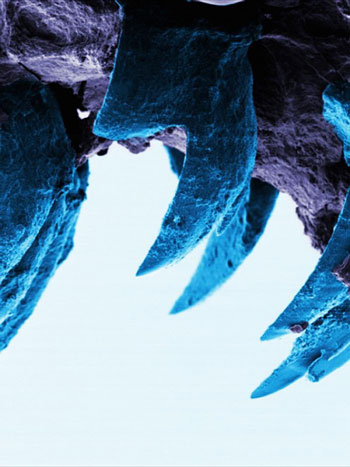Limpet teeth break strength record
Fibre-reinforced composite materials in nature

In many applications, we need materials that are both strong and lightweight, especially for aircraft, boats, and cars. Some of the best are composite materials, because they combine different materials to utilize most of their advantages but also cancel out each other’s defects. In particular, hard but brittle materials are often combined with softer but more flexible materials. Concrete with steel bars is a well-known combination—reinforced concrete—since concrete resists compression and steel resists tension.
In recent years, the great strength of biological materials such as bone,1 and shell2 has been shown to result from such combinations of hard and brittle minerals combined with flexible proteins. The strength is further enhanced by their ingenious structures.
A well-known man-made composite material is ‘fibreglass’, really fiberglass-reinforced plastic. Here, glass is the hard and usually brittle material, and plastic is the flexible material. Bulk glass is brittle because it has structural defects or flaws. These flaws concentrate stresses, and cracks start at these defects then propagate through the material. However, fibres are thin enough—4–34 microns3 (µm) in diameter that they can be made almost defect-free. This is why they are so flexible. Also, if a crack does manage to develop, it just breaks one fibre, not the entire piece of material. If a large sheet could be made defect-free, it would be as strong as the fibres, but this is impractical.
Limpet fibreglass teeth

Now it turns out that a humble sea snail (class: Gastropoda) has teeth made with these advanced materials-science principles. The limpet clings very strongly to rocks with the suction of its muscular foot, plus adhesive mucus. But they do move around. For food, it uses its tongue (radula) covered with tiny teeth to scrape algae off the rocks. In the process, it breaks particles off the rocks themselves, swallows them, then excretes them. Indeed, limpets are eating away the famous white cliffs of Dover at a rate of 1.3 mm/year.4
Now some engineers and materials scientists, led by Prof. Asa Barber of the University of Portsmouth, have discovered the limpets’ secret.5,6 Their teeth are made of the strongest biological material yet discovered, due to a sort of fibreglass principle. The fibres are made of a substance chemically similar to rust: an iron oxide/hydroxide mineral called goethite. And they are about a thousand times thinner than the glass fibres in fiberglass: the goethite fibres are only tens of nanometres7 (nm) in diameter and a few microns long. This is so thin that it’s below a “flaw tolerant critical size” of about 30 nm. That is, it’s so small that defects don’t concentrate stress and become the starting points of cracks.8
This extreme thinness could well inspire the design of far stronger composite materials than we have at present. It’s also notable that the researchers say, “natural design in limpet teeth is optimized towards theoretical strength limits.”9 Prof. Barber also said: “Biology is a great source of inspiration as an engineer. These teeth are made up of very small fibres, put together in a particular way and we should be thinking about making our own structures following the same design principles.”
Once again, we see human designers trying to learn from the design in nature, which points to the Designer of nature so strongly that people have no excuse (Romans 1:18–25).

References and notes
- Sarfati, J., Bone building: perfect protein, J. Creation 18(1):11–12, 2004; creation.com/bone. Return to text.
- Sarfati, J., Amazing abalone armour Creation 30(1):44–45, 2007; creation.com/abalone and; Super shells, Creation 27(3):19, 2005; creation.com/conch. Return to text.
- 1 micron (or micrometre) = 10–6 m; 1,000 µm = 1 mm; human hair ranges from 17 to 181 µm. Return to text.
- Is it all over, for white cliffs of Dover? (Focus), Creation 22(3):5, 2000. Return to text.
- Barber, A., Lu, D. and Pugno, N.M., Extreme strength observed in limpet teeth, Journal of the Royal Society Interface 12(105), 18 February 2015 | doi: 10.1098/rsif.2014.1326. Return to text.
- Webb, J., Limpet teeth set new strength record, BBC News, 17 Feb. 2015, bbc.com. Return to text.
- 1 nm = 10–9 m. Return to text.
- Gao, H.J. et al., Materials become insensitive to flaws at nanoscale: lessons from nature, Proceedings of the National Academy of Sciences USA 100(10):5597–5600, 13 May 2003 | doi:10.1073/pnas.0631609100. Return to text.
- Barber et al., Ref. 5, abstract. Return to text.



Readers’ comments
Comments are automatically closed 14 days after publication.